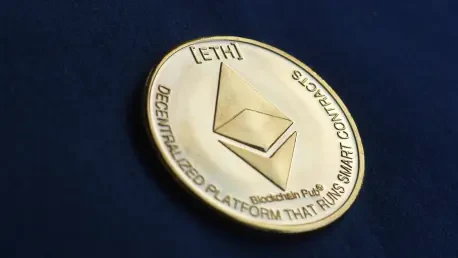Kofi Ndaikate is an acclaimed fintech analyst whose expertise in blockchain and cryptocurrency is sought after around the globe. With a nuanced understanding of Ethereum’s market cycles and its technical patterns, Kofi offers insights into what these signals mean for investors navigating this volatile market. Today, we explore emerging formations like the symmetrical triangle, predictive technical indices, and investor behavior affecting Ethereum’s dynamic landscape.
Can you explain the significance of the double top pattern emerging near the $4,000 resistance level for Ethereum?
The double top pattern near the $4,000 resistance level is significant as it often signals a potential reversal from bullish to bearish sentiment. It’s a classic technical pattern that indicates that the levels have been tested twice and failed to break through. For Ethereum, this suggests that there might be underlying weakness in its bullish momentum, making investors more cautious about any long-term upward moves unless these resistance levels are convincingly breached.
How does the symmetrical triangle formation affect Ethereum’s current trading range and what does it indicate for its future price movement?
A symmetrical triangle is typically seen as a consolidation pattern, where the price is pushing within a narrowing trading range. With Ethereum confined between $2,200 and $2,870, this formation suggests a period of indecision in the market. As the triangle develops, it builds pressure and is poised for a breakout. If we see a breakout above the triangle, it could indicate the beginning of a bullish trend; however, a breakdown might lead to further bearish movement.
What role does the 50-month EMA play in Ethereum’s current price dynamics and how does it act as a dynamic support level?
The 50-month EMA is crucial because it provides a long-term trend perspective, capturing sustained price movement. For Ethereum, it’s acting as dynamic support around the $2,229 level, a point where buyers have consistently entered to prevent further decline. This support suggests investor confidence at this price, and if it holds, it can be a springboard for future upward momentum, helping stabilize the asset in turbulent times.
Could you elaborate on the importance of the neckline between $2,130 and $2,200 for traders? What might a breakdown below this level imply?
The neckline between $2,130 and $2,200 is pivotal as it represents the last line of defense before entering bearish territory. For traders, maintaining prices above this level is crucial to preserve the current price structure. A breakdown here could signal increased selling pressure, possibly accelerating bearish sentiment and driving prices down towards lower support levels or even sparking a new downtrend.
How do RSI and MACD indicators currently reflect Ethereum’s momentum, and why is it important for traders?
The RSI and MACD are vital indicators for gauging momentum and potential trend reversals. Currently, Ethereum’s RSI near 46 suggests neutral momentum, lacking the strength found in a bullish or bearish trend. The negative MACD points to a persistent lack of upward momentum. Together, these indicators highlight investor caution and hesitation, which traders should consider when assessing the likelihood of significant price shifts.
What signs or signals should traders watch for when considering a potential breakout above the $2,525 level?
Traders should look for increased trading volume as a sign of genuine investor interest, indicating a breakout is likely to sustain. Positive shifts in momentum indicators like the RSI moving upward or a bullish MACD crossover could further support breakout potential. Additionally, if the price can consolidate above $2,525, it suggests more buyers are willing to hold, potentially flipping the trend bullish.
Considering the current low volatility as suggested by compressing Bollinger Bands, what scenarios could lead to a significant price breakout?
Compressed Bollinger Bands often hint at impending volatility spikes. For Ethereum, catalysts such as major policy changes, technological advancements, or shifts in global investor sentiment could trigger significant movements. A breakout could also be driven by institutional buying or large-scale events impacting broader financial markets, leading to Ethereum’s price escaping its current range.
Despite short-term challenges, some analysts remain optimistic about Ethereum’s long-term potential. What factors contribute to projections such as Ethereum reaching $50,000 in five years?
Long-term optimism stems from Ethereum’s foundational role in the broader cryptocurrency ecosystem, including its smart contract capabilities and decentralized application hosting. The upcoming network upgrades to improve scalability and reduce transaction costs further bolster its prospects. Additionally, institutional adoption and use cases expanding beyond crypto trading into areas like decentralized finance (DeFi) support a bullish outlook, contributing to lofty predictions.
How do the recent long-side liquidations compared to short-side liquidations impact the current sentiment around Ethereum?
The recent surge in long-side liquidations suggests that bullish sentiment had overstretched, leading to forced selling as prices couldn’t sustain upward pressure. This contrast with lower short liquidations signals a shift towards caution or bearish sentiment, as market players reevaluate the balance between risk and reward in their positions. It reflects a cooling in enthusiasm, possibly leading to more conservative trading strategies.
Can you discuss the implications of the $44.13 million ETH outflows from exchanges and how it contrasts with liquidations and stagnant price action?
Typically, outflows are bullish as they suggest accumulation; however, given the high liquidation figures and stagnant price movements, these outflows might actually reflect risk management strategies rather than bullish accumulation. Investors could be preparing for potential downside by moving assets off exchanges, signaling caution while adjusting their portfolios in response to price volatility.
Describe the significance of the $2,870 resistance level and the $2,200 support level in shaping Ethereum’s current market bias.
The $2,870 resistance level marks a point where sellers have repeatedly halted price increases, challenging bullish attempts. Conversely, the $2,200 support acts as a buffer against declines, where buyers have historically defended the price. These thresholds are crucial in shaping market bias by dictating investor strategies—whether to buy at support or sell at resistance. Breaking either could shift sentiment dramatically.
What does the recent whale accumulation that helped lift Ethereum’s price back toward the $2,400 level suggest about investor behavior?
Whale accumulation indicates significant investor interest and potential confidence in Ethereum’s value proposition. Such large-scale buying activities hint at a strategic belief in long-term price appreciation or undervaluation at current levels. It suggests that seasoned investors are willing to bet on Ethereum’s stability or potential rebound, impacting short-term price dynamics and fostering hope in a recovery.
How is Best Wallet attracting attention as Ethereum consolidates, and what features make it appealing to traders?
Best Wallet is emerging as a popular choice as it offers robust features highly sought by traders and investors. Its multichain support facilitates easier asset management across different blockchains, and real yield mechanisms add value beyond mere asset holding. Moreover, AI-based asset tracking provides advanced analytical capabilities, aiding traders in making informed decisions. As Ethereum consolidates, these features offer additional tools to navigate market uncertainties.
In your opinion, why is it important for financial reporting to be both unbiased and transparent when discussing market trends and potential investment opportunities?
Unbiased and transparent reporting is vital because it enables investors to make informed decisions without being swayed by subjective or incomplete information. In volatile markets, transparency helps demystify price movements and underlying factors, promoting trust and confidence among market participants. It ensures narratives reflect true market conditions, allowing investors to better assess risks and opportunities inherent in their strategies.









